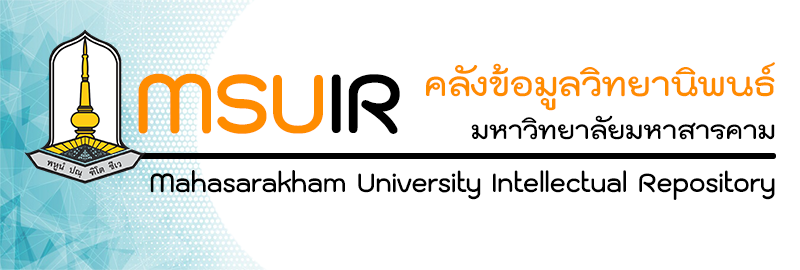Please use this identifier to cite or link to this item:
http://202.28.34.124/dspace/handle123456789/2858| Title: | The Development of Educational Institution Management Guidelines Based on Good Governance Principles for The Secondary Educational Service Area Office Buriram การพัฒนาแนวทางการบริหารสถานศึกษาโดยยึดหลักธรรมาภิบาลสำหรับโรงเรียน สังกัดสำนักงานเขตพื้นที่การศึกษามัธยมศึกษาบุรีรัมย์ |
| Authors: | Chayavat Saingram ชญาวัต สอิ้งรัมย์ Pacharawit Chansirisira พชรวิทย์ จันทร์ศิริสิร Mahasarakham University Pacharawit Chansirisira พชรวิทย์ จันทร์ศิริสิร wittaya.c@msu.ac.th wittaya.c@msu.ac.th |
| Keywords: | การบริหารสถานศึกษา หลักธรรมาภิบาล การพัฒนาแนวทาง school administration good governance guideline development |
| Issue Date: | 9 |
| Publisher: | Mahasarakham University |
| Abstract: | This study aims to 1) investigate the current state, desirable conditions, and essential needs of school administration based on the principles of good governance, and 2) develop guidelines for school administration based on the principles of good governance for schools under the supervision of the Secondary Educational Service Area Office in Buriram. The research utilized a mixed-methods design conducted in two phases. In Phase 1, the study focused on the current conditions, desirable conditions, and necessary needs for school administration based on the principles of good governance. The sample comprised 344 participants, including 83 school administrators and 261 teachers. The sample size was determined using Krejcie and Morgan's table, and the stratified random sampling technique was applied based on the sizes of educational institutions. To determine the final participant groups, a proportional sample size for each stratum was then determined. This evaluation involved five qualified experts. The research tools comprised questionnaires. In Phase 2, guidelines for school administration based on the principles of good governance were developed for schools under the supervision of the Secondary Educational Service Area Office in Buriram. This involved interviewing 11 school administrators from three schools that demonstrated best practices, selected through targeted sampling. Five qualified experts conducted the evaluation. The research tools included structured interview forms, suitability assessment forms, and feasibility assessment forms. Statistical analyses employed in data analysis included percentages, means, and standard deviations.
The research findings indicate that:
1. The current state of school administration, following the principles of good governance for schools under the supervision of the Secondary Educational Service Area Office in Buriram, is generally high. When examining specific aspects, it is rated high in two areas and moderately in two areas, with the average scores ranging from high to low. These areas include academic management, general management, personnel management, and budget management. The preferred condition for school administration, adhering to the principles of good governance for schools under the Secondary Educational Service Area Office in Buriram, is at the highest level overall. When examining specific aspects, the scores are highest for personnel management, budget management, general management, and academic management.
2. The developed guidelines for school administration, grounded in the principles of good governance, consist of four dimensions and 24 recommendations. The overall evaluation indicates that their suitability is at the highest level, and their overall feasibility is also at the highest level. การวิจัยครั้งนี้มีวัตถุประสงค์เพื่อ 1) ศึกษาสภาพปัจจุบัน สภาพที่พึงประสงค์และความต้องการจำเป็นของการบริหารสถานศึกษาโดยยึดหลักธรรมาภิบาลสำหรับโรงเรียน และ 2) พัฒนาแนวทางการบริหารสถานศึกษาโดยยึดหลักธรรมาภิบาลสำหรับโรงเรียน สังกัดสำนักงานเขตพื้นที่การศึกษามัธยมศึกษาบุรีรัมย์ เป็นการวิจัยแบบผสมผสาน การวิจัยแบ่งเป็น 2 ระยะ ระยะที่ 1 ศึกษาสภาพปัจจุบัน สภาพที่พึงประสงค์ และความต้องการจำเป็นการบริหารสถานศึกษาโดยยึดหลักธรรมาภิบาลสำหรับโรงเรียน สังกัดสำนักงานเขตพื้นที่การศึกษามัธยมศึกษาบุรีรัมย์ ผู้ให้ข้อมูลได้กลุ่มตัวอย่าง จำนวน 344 คน ได้แก่ ผู้บริหารสถานศึกษา จำนวน 83 คนและครูผู้สอน จำนวน 261 คน กำหนดขนาดกลุ่มตัวอย่างโดยใช้ตารางเครจซี่และมอร์แกน และใช้เทคนิคการสุ่มแบบแบ่งชั้นภูมิ จำแนกตามขนาดของสถานศึกษา แล้วนำมาคำนวณหาจำนวนกลุ่มตัวอย่างตามสัดส่วนของประชากรในแต่ละชั้นภูมิ เครื่องมือที่ใช้ในการวิจัย ได้แก่ แบบสอบถาม ระยะที่ 2 พัฒนาแนวทางการบริหารสถานศึกษาโดยยึดหลักธรรมาภิบาลสำหรับโรงเรียน สังกัดสำนักงานเขตพื้นที่การศึกษามัธยมศึกษาบุรีรัมย์ โดยการสัมภาษณ์ผู้บริหารสถานศึกษาจากโรงเรียนที่มีการบริหารตามหลักธรรมาภิบาลที่มีวิธีปฏิบัติที่ดี (Best Practice) 3 โรงเรียน จำนวน 11 คน ได้มาจากการเลือกแบบเจาะจง เพื่อใช้เป็นแนวทางยกร่างและประเมินแนวทางการบริหารสถานศึกษาโดยยึดหลักธรรมาภิบาลสำหรับโรงเรียน สังกัดสำนักงานเขตพื้นที่การศึกษามัธยมศึกษาบุรีรัมย์ โดยผู้ทรงคุณวุฒิ 5 คน เครื่องมือที่ใช้ในการวิจัย ได้แก่ แบบสัมภาษณ์แบบมีโครงสร้าง แบบประเมินความเหมาะสม และความเป็นไปได้ของแนวทาง สถิติที่ใช้ในการวิเคราะห์ข้อมูล คือ ร้อยละ ค่าเฉลี่ย และส่วนเบี่ยงเบนมาตรฐาน ผลการวิจัยพบว่า 1. สภาพปัจจุบันการบริหารสถานศึกษาโดยยึดหลักธรรมาภิบาลสำหรับโรงเรียน สังกัดสำนักงานเขตพื้นที่การศึกษามัธยมศึกษาบุรีรัมย์ โดยรวมอยู่ในระดับมาก เมื่อพิจารณาเป็นรายข้อ พบว่า อยู่ในระดับมาก 2 ข้อ และอยู่ในระดับปานกลาง 2 ข้อ เรียงลำดับคะแนนเฉลี่ยจากมากไปหาน้อย ได้แก่ การบริหารวิชาการ การบริหารทั่วไป การบริหารงานบุคคล และการบริหารงบประมาณ สภาพที่พึงประสงค์การบริหารสถานศึกษาโดยยึดหลักธรรมาภิบาลสำหรับโรงเรียน สังกัดสำนักงานเขตพื้นที่การศึกษามัธยมศึกษาบุรีรัมย์ โดยรวมอยู่ในระดับมากที่สุด เมื่อพิจารณาเป็นรายข้อ พบว่า อยู่ในระดับมากที่สุดทั้ง 4 ข้อ เรียงลำดับคะแนนเฉลี่ยจากมากไปหาน้อย ได้แก่ การบริหารงานบุคคล การบริหารงบประมาณ การบริหารทั่วไป และการบริหารวิชาการ 2. แนวทางการบริหารสถานศึกษาโดยยึดหลักธรรมาภิบาลสำหรับโรงเรียน สังกัดสำนักงานเขตพื้นที่การศึกษามัธยมศึกษาบุรีรัมย์ ประกอบด้วย 4 ด้าน 24 แนวทาง ผลการประเมินความเหมาะสมโดยรวมอยู่ในระดับมากที่สุด และความเป็นไปได้ของแนวทางโดยรวมอยู่ในระดับมากที่สุด |
| URI: | http://202.28.34.124/dspace/handle123456789/2858 |
| Appears in Collections: | The Faculty of Education |
Files in This Item:
| File | Description | Size | Format | |
|---|---|---|---|---|
| 65010581014.pdf | 10.73 MB | Adobe PDF | View/Open |
Items in DSpace are protected by copyright, with all rights reserved, unless otherwise indicated.

